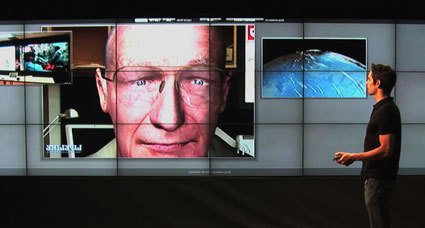SAGE™ software enables teams of users to manage their data in a room covered with displays, as if the room were one seamless canvas. SAGE lets users post and manipulate information, visualizations and animations. The goal of SAGE is to make it possible for people to look at large amounts of information and come to conclusions with greater speed, accuracy, comprehensiveness and confidence.
SAGE was originally conceived in 2004. With National Science Foundation (NSF) funding in 2009, the SAGE team was able to continue to develop and harden SAGE, thereby helping over 100 major institutions worldwide better utilize content on their display walls with SAGE.
With NSF funding in 2013, the SAGE team had an opportunity to develop SAGE2, the next-generation SAGE. SAGE is being rewritten from the ground up, using new and emerging technologies.
SAGE2 is browser-based, and everything is done from the Chrome web browser. Special software is no longer needed. By simply dragging and dropping content from one’s laptop to a visual representation of the wall in the browser, one can transfer the content to the wall.
The user interface has been completely redesigned to make it easier and faster for users to work on really large display walls. The SAGE2 interface emphasizes transportable interfaces rather than stationary interfaces so a user can control SAGE2 from anywhere in a room (or even away from the room). Entire laptop screens can also be pushed onto windows in SAGE2, again directly leveraging browser technology. SAGE2 also enables users to connect to collaborating SAGE2 walls and send documents among them by simply dragging and dropping the content in specially marked “collaboration folders”.
Custom applications are easily built in SAGE2. While SAGE is written in C++, SAGE2 is written entirely in Javascript. SAGE2 includes a small software toolkit that enables users to develop applications or modify existing applications to work seamlessly across multiple displays in a synchronized fashion. This unleashes the possibility of creating a new generation of applications that can take advantage of the special qualities of ultra-high-resolution display walls.
SAGE™: Scalable Adaptive Graphics Environment
In 2009, the University of Illinois at Chicago (UIC) Electronic Visualization Laboratory (EVL) was awarded a three-year, $1.9-Million grant from the National Science Foundation (NSF), award # OCI-0943559, for “OptIPlanet Cyber-Mashup,” to create persistent visualization and collaboration services for global cyberinfrastructure. This award enables EVL to further develop, enhance and deploy its popular SAGE middleware to a burgeoning international user community.
As globally distributed research teams work more closely to solve complex problems utilizing advanced cyberinfrastructure, from petascale computers to specialized instrumentation that generates massive amounts of data, the need for collaborative scientific visualization environments is becoming critical for data sharing and analysis, and is propelling the worldwide adoption of ultra-resolution tiled display walls interconnected by optical networks. Also required is a globally connected and well-integrated “operating environment” that provides persistent visualization and collaboration services.
SAGE™ provides such a common environment, or framework, enabling its users to access, display and share a variety of data-intensive information, in a variety of resolutions and formats, from multiple sources, on tiled display walls of arbitrary size. This information can be digital-cinema animations, high-resolution images, high-definition video-teleconferences, presentation slides, documents, spreadsheets or laptop screens. SAGE is cross-platform, community-driven, open-source visualization and collaboration middleware that utilizes shared national and international cyberinfrastructure for the advancement of scientific research and education.
SAGE™ and OptIPortals (tiled display walls) are an outgrowth of the National Science Foundation (NSF) funded OptIPuter project, whose goal was to enable collaborating scientists to interactively explore massive amounts of previously uncorrelated data by developing a radical new architecture for shared e-science information technology facilities. Early adapters have already created a burgeoning international user community that is referred to as the OptIPlanet Collaboratory.
SAGE team members are from the Laboratory for Advanced Visualization & Applications at University of Hawai‘i at Mānoa and the Electronic Visualization Laboratory at University of Illinois at Chicago.
SAGE/SAGE2 receives major support from the National Science Foundation award # ACI-1441963.
